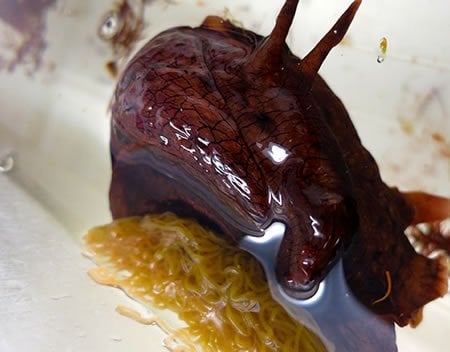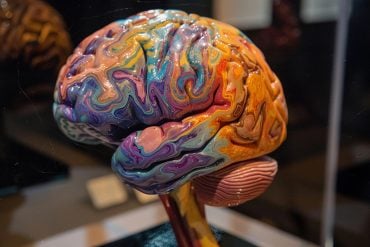Study of ‘senior citizen’ marine snails uncovered how nerve cells fail during learning.
A new research study on marine snails uncovered the first cells in the nervous system to fail during aging. The University of Miami (UM) Rosenstiel School of Marine and Atmospheric Science researchers’ findings are important to better understanding the underlying mechanisms of age-related memory loss in humans.
Scientists performed tail reflex experiments on the hatchery-reared California sea hare Aplysia californica, which has a one-year lifespan and is a common neurological model used to understand the function of the nervous system. They studied two distinct age groups in families of snails – reproductive maturity and old age. The tail startle reflex of the animal is known to slow, lessen, and finally disappear as it ages.
The researchers measured tail response learning to electric shock to determine patterns of aging in both the nerve cell that senses touch of the tail, called sensory neurons, and the motor neurons that signal the tail muscle to contract.

“In a previous study focused on identification of the first cells in the nervous system to fail during aging of this reflex we found that sensory neuron aging drives aging of the circuit, said Lynne Fieber, associate professor of marine biology and ecology at the UM Rosenstiel School. “Here we examined the performance of sensory and motor neurons in short-term memory, and found that both neuron types had impaired performance in old Aplysia.”
The learning experiment, called sensitization, exposed each animal to a repeated stimulus of varying intensities to gauge its reaction. The sensitization experiment should result in a forceful tail contraction to a tail touch, the result of the animals learned reaction to a more intense stimulus, in this case an electric shock.
The results showed that short-term sensitization to tail touch was absent in aged Aplysia californica, and that the sensory and motor neurons were affected by aging in specific ways, which resulted in an inability of old animals to learn.
“The failure of these animals to learn sensitization may be related to the inability of their aged neurons to respond to chemical messengers,” said Fieber.
Funding: This research was supported by the National Institutes of Health, Maytag Foundation, and Korein Foundation.
Source: Diana Udel – University of Miami Rosenstiel School of Marine and Atmospheric Science
Image Credit: The image is credited to Michael Schmale, Ph.D.
Original Research: Full open access research for “Aging in Sensory and Motor Neurons Results in Learning Failure in Aplysia californica” by Andrew T. Kempsell and Lynne A. Fieber in PLOS ONE. Published online May 13 2015 doi:10.1371/journal.pone.0127056
Abstract
Aging in Sensory and Motor Neurons Results in Learning Failure in Aplysia californica
The physiological and molecular mechanisms of age-related memory loss are complicated by the complexity of vertebrate nervous systems. This study takes advantage of a simple neural model to investigate nervous system aging, focusing on changes in learning and memory in the form of behavioral sensitization in vivo and synaptic facilitation in vitro. The effect of aging on the tail withdrawal reflex (TWR) was studied in Aplysia californica at maturity and late in the annual lifecycle. We found that short-term sensitization in TWR was absent in aged Aplysia. This implied that the neuronal machinery governing nonassociative learning was compromised during aging. Synaptic plasticity in the form of short-term facilitation between tail sensory and motor neurons decreased during aging whether the sensitizing stimulus was tail shock or the heterosynaptic modulator serotonin (5-HT). Together, these results suggest that the cellular mechanisms governing behavioral sensitization are compromised during aging, thereby nearly eliminating sensitization in aged Aplysia.
“Aging in Sensory and Motor Neurons Results in Learning Failure in Aplysia californica” by Andrew T. Kempsell and Lynne A. Fieber in PLOS ONE. Published online May 13 2015 doi:10.1371/journal.pone.0127056






